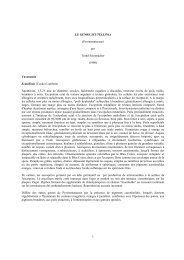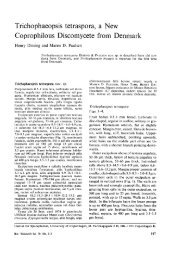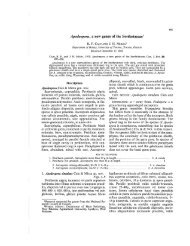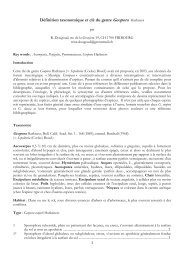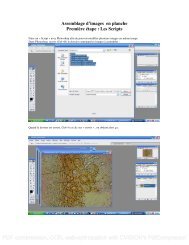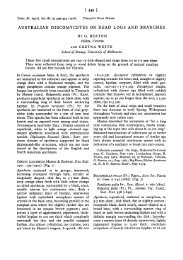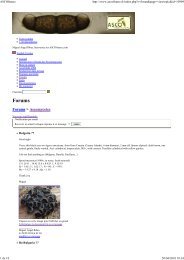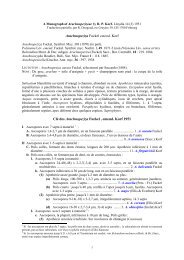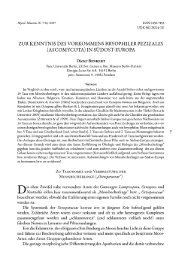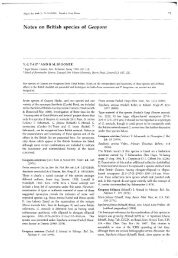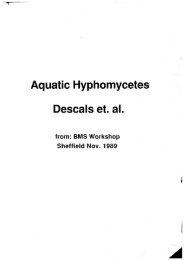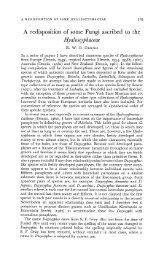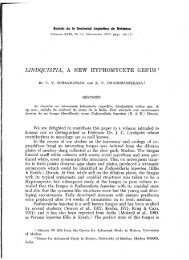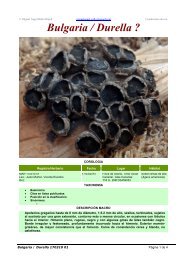Stray Studies in the Coronophorales (Pyrenomycetes) 4-8 - ASCOfrance
Stray Studies in the Coronophorales (Pyrenomycetes) 4-8 - ASCOfrance
Stray Studies in the Coronophorales (Pyrenomycetes) 4-8 - ASCOfrance
Create successful ePaper yourself
Turn your PDF publications into a flip-book with our unique Google optimized e-Paper software.
298 J. A. Nannfeldtto his own Nitschkieae, and so he transferred three alleged Fracchiaeae with"Quellkörper" and cupulate ascocarps to Höhnel's group. In <strong>the</strong> present paper<strong>the</strong>se species are put back <strong>in</strong>to Fitzpatrick's group and <strong>in</strong>cluded <strong>in</strong> Nitschkia.year before, when establish<strong>in</strong>g his Nitschkieae,TheFitzpatrick (1923) had evidently notbecome observant of this structure, for <strong>in</strong> one of his own still preserved slides (FH)of Ac. macrobarbata (i.e. Ac. foveolata) a large "Quellkörper" is readily seen.It must be presumed that <strong>the</strong> "Quellkörper" play an important rôle <strong>in</strong> <strong>the</strong> sporedischarge or at least have played such a rôle dur<strong>in</strong>g <strong>the</strong> evolution of <strong>the</strong> <strong>Coronophorales</strong>,but how <strong>the</strong>y function is not known.Such ± prolonged subcyl<strong>in</strong>drical to <strong>in</strong>verted-conical "Quellkörper", which mayeven reach almost down to <strong>the</strong> bottom of <strong>the</strong> locule, occur <strong>in</strong> <strong>the</strong> follow<strong>in</strong>gNitschkieae:Ac. foveolata (ca. 300 fim long)Ac. pulchella (ca. 200 f<strong>in</strong>i)N. acanthostroma (ca. 250 /xm; Fig. \g, fur<strong>the</strong>r ill. Werdermann 1923, Arx & Müller1954:379 (<strong>in</strong>accurate)N. aff<strong>in</strong>is (ra<strong>the</strong>r short?)"Fracchiaea australis" (ca. 200 /im; ill. Fitzpatrick 1924)N. callista (ra<strong>the</strong>r short?; Fig. Id)N. chaetomioides (ca. 300 /xm; Fig. lc)N. confertula (ra<strong>the</strong>r short; Figs, le,/, fur<strong>the</strong>r ill. Müller & Arx 1955 (<strong>in</strong>accurate)N. leonensis (ca. 250 ju.ni; ill. Sivanesan 1974)N. similis (ca. 200 /im; ill. Arx & Müller 1954)N. uniseriata (ca. 120 /im).The "Quellkörper" consist of concentrically and transversely orientated, firmlyconglut<strong>in</strong>ated cells with very thick, hyal<strong>in</strong>e, strongly refractive walls and narrowlum<strong>in</strong>a (Figs, lc, d,f). The parabolically roùnded apex shows a fr<strong>in</strong>ge of longitud<strong>in</strong>alhyphae. In N. callista <strong>the</strong>se hyphae have thick walls and narrow lum<strong>in</strong>a and curveparabolically <strong>in</strong>wards. In N. leonensis <strong>the</strong>y are th<strong>in</strong>-walled with larger lum<strong>in</strong>a (thusresembl<strong>in</strong>g normal periphyses), ra<strong>the</strong>r straight and convergent as to circumscribe acone. N. chaetomioidesis ± <strong>in</strong>termediate with curved and ra<strong>the</strong>r thick-walled hyphaebut still ample lum<strong>in</strong>a.In o<strong>the</strong>r Nitschkieae<strong>the</strong> "Quellkörper" is replaced by a low perforated "cushion".Höhnel (1918:138) found that <strong>in</strong> Fracchiaea heterogenea (=N. broomeiana)<strong>the</strong> hyal<strong>in</strong>e layer of <strong>the</strong> peridium thickens apically (from ca. 20 /xm to ca. 70 /xm),"ist hier rundlich durchbrochen und löst sich hier <strong>in</strong> e<strong>in</strong>en Kranz von Periphysenauf. Diese <strong>in</strong>nere hyal<strong>in</strong>e Schicht hat daher e<strong>in</strong> typisches Ostiolum". Such "cushions",which may be <strong>in</strong>terpreted as ei<strong>the</strong>r <strong>in</strong>cipient or reduced "Quellkörper", haveso far been observed <strong>in</strong>:Gaillardiella pezizoides (ill. Müller & Arx 1962)N. brevisp<strong>in</strong>aN. broomeiana (Figs. 2a, b)Svensk Bot. Tidskr. 69 (1975)



